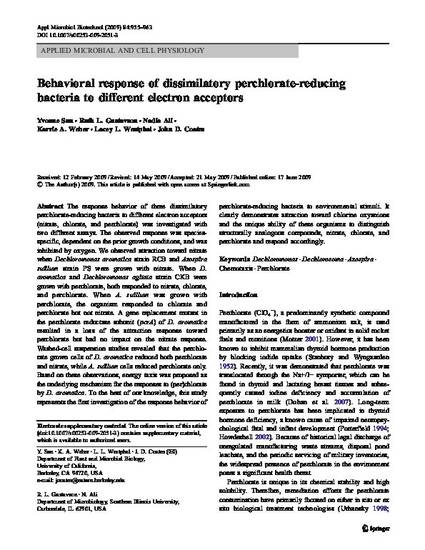
Appl Microbiol Biotechnol (2009) 84:955–963; DOI 10.1007/s00253-009-2051-3
The response behavior of three dissimilatory perchlorate-reducing bacteria to different electron acceptors (nitrate, chlorate, and perchlorate) was investigated with two different assays. The observed response was speciesspecific, dependent on the prior growth conditions, and was inhibited by oxygen. We observed attraction toward nitrate when Dechloromonas aromatica strain RCB and Azospira suillum strain PS were grown with nitrate. When D. aromatica and Dechloromonas agitata strain CKB were grown with perchlorate, both responded to nitrate, chlorate, and perchlorate. When A. suillum was grown with perchlorate, the organism responded to chlorate and perchlorate but not nitrate. A gene replacement mutant in the perchlorate reductase subunit (pcrA) of D. aromatica resulted in a loss of the attraction response toward perchlorate but had no impact on the nitrate response. Washed-cell suspension studies revealed that the perchlorate grown cells of D. aromatica reduced both perchlorate and nitrate, while A. suillum cells reduced perchlorate only. Based on these observations, energy taxis was proposed as the underlying mechanism for the responses to (per)chlorate by D. aromatica. To the best of our knowledge, this study represents the first investigation of the response behavior of perchlorate-reducing bacteria to environmental stimuli. It clearly demonstrates attraction toward chlorine oxyanions and the unique ability of these organisms to distinguish structurally analogous compounds, nitrate, chlorate, and perchlorate and respond accordingly.
Includes 3 supplemental figures.
Available at: http://works.bepress.com/yvonne_sun/1/

Copyright (c) 2009 the Authors. This article is distributed under the terms of the Creative Commons Attribution Noncommercial License